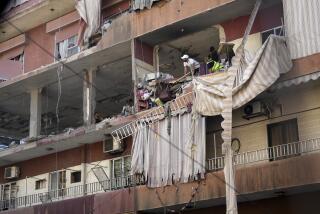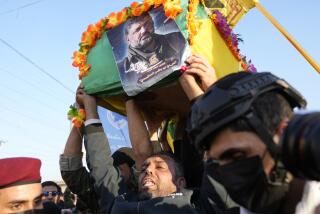Uprising Could Signal a Second War for Iraq
- Share via
WASHINGTON — The widespread insurgency that has erupted in Iraq in recent days may be the first stages of a second war for the country that could determine whether the conflict degenerates into a military bog for the United States.
The outbreak of violence by Shiite Muslim militiamen, coupled with attacks by former Iraqi regime allies and small numbers of foreign fighters, is prompting U.S. commanders to assess how many troops are needed and how they should be used.
The uprising has also raised questions about past military decisions in the yearlong invasion and occupation of Iraq.
“We’re at a tipping point in Iraq, with a real danger of losing control of the situation,” Samuel R. “Sandy” Berger, who was national security advisor to President Clinton, said in a National Public Radio interview.
The military setbacks have also generated comparisons with Vietnam and calls to consider leaving.
“It’s time to bail out,” said Charles V. Pena, director of defense policy studies at the Cato Institute, a conservative Washington think tank. “If it wasn’t obvious beforehand, it ought to be more obvious now that we are in a situation that is no longer in control, and we can’t make the fairy tale outcome that we would like to see happen in Iraq.”
As a result of the new violence, Defense Secretary Donald H. Rumsfeld put troops in Iraq on notice Wednesday that they soon might be asked to serve beyond their one-year tours. And Army Gen. John Abizaid, head of the U.S. Central Command, has asked for plans to ferry in extra troops if he decides they are needed.
Within Iraq, commanders are now confronting the street-to-street, house-to-house combat they thought they had dodged in last year’s rapid invasion.
At the time, the strategy of bypassing major Iraqi cities to avoid bloody battles as troops headed toward Baghdad was lauded. Observers marveled that Iraqi army fighters seemed to melt away before the advancing U.S. and allied forces.
But having avoided major combat in anti-American hotbeds such as Fallouja and Ramadi, west of Baghdad, the U.S.-led coalition left large blocks of opposition to fester.
“A few now have come back and want to fight -- not totally unexpected -- and have to be dealt with. And we’ve been doing that,” said Air Force Gen. Richard B. Myers, chairman of the Joint Chiefs of Staff.
Adding to that problem, U.S.-led forces largely left inner-city security to Iraqi units over the winter. The result, as Rumsfeld acknowledged Wednesday, is that the coalition has lost control of parts of Iraq, including Najaf, where firebrand cleric Muqtader Sadr is now thought to be hiding and his Al Mahdi militia is in control of a key shrine.
Troops are now being forced to engage in the urban warfare and take areas that were left off the military plans the first time coalition forces came through. Still, Myers said Wednesday that “it was not a mistake” last year to avoid battle with Saddam Hussein’s allies in major cities en route to Baghdad.
The small but lethal opposition spreading across Iraq was laid out for reporters at the Pentagon on Wednesday. On a map, arrows pointed to the trouble spots -- Ramadi, Fallouja, Baghdad, Karbala, Najaf, Kut, Amarah, Nasiriya and Basra.
Red arrows marked attacks thought to have been launched by Hussein’s former Baath Party supporters and Abu Musab Zarqawi, an accused terrorist whom the Bush administration has linked to the Al Qaeda terrorist network. Green arrows stood for attacks by forces loyal to Sadr.
Pentagon officials acknowledge that there is active coordination between the mostly Sunni Muslim allies of the ousted Hussein and foreign Arabs who use car bombs and other terrorist tactics. But they see no alliance between Sunni insurgents and Sadr’s Shiite forces.
Yet even Rumsfeld acknowledged that the emergence of the Shiite forces in Baghdad and southern cities had inspired anti-coalition guerrillas in other areas, who this week attacked coalition troops and Iraqi police with newfound ferocity. Since Sunday, at least 35 coalition troops and perhaps as many as 175 Iraqis have been killed.
Some Pentagon officials have groused that the Shiite uprising could have been averted if U.S. commanders in Iraq had arrested Sadr, who has been accused in the slaying of a fellow cleric.
Last week, a key aide to Sadr was arrested in the case and the U.S. shut down a Sadr-backed newspaper, accusing it of inciting violence against the coalition.
Rumsfeld told reporters that U.S. forces “knew that Sadr would react,” but commanders on the ground were apparently surprised by the ferocity of the Al Mahdi assault that began Sunday as militia members attacked government buildings and police stations. Eight U.S. troops were slain in Baghdad.
“In retrospect, we should have grabbed him instead of shutting down his newspaper,” a senior defense official said.
Nevertheless, Rumsfeld acknowledged Wednesday that troops have stayed away from Najaf, one of Iraq’s holiest cities for Shiite Muslims, to avoid inflaming passions, particularly as a major religious holiday approaches this weekend.
Some observes said Wednesday that they saw parallels other than Vietnam if the coalition continued to engage in heavy fighting with Sadr’s militia.
“If the current situation unravels, the U.S. military will be faced with its own version of the Israeli occupation of the West Bank, where military action to suppress the insurgency creates more new insurgents and an endless cycle of violence,” Pena said.
Times staff writer Paul Richter in Washington contributed to this report.
--- UNPUBLISHED NOTE ---
In stories after April 9, 2004, Shiite cleric Muqtader Sadr is correctly referred to as Muqtada Sadr.
--- END NOTE ---
More to Read
Sign up for Essential California
The most important California stories and recommendations in your inbox every morning.
You may occasionally receive promotional content from the Los Angeles Times.










